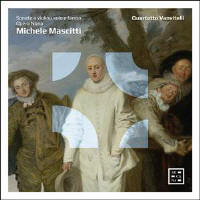Texte paru dans: / Appeared in: |
|
|
Outil de traduction ~ (Très approximatif) |
|
|
Reviewer: Raymond
Tuttle
As I was auditioning this CD,
my cat sauntered in, looked up at me, and trilled inquisitively, “Corelli?”
No, not Corelli, little one, but that is a good guess, because it has been
suggested that Michele Mascitti (1664–1760) did in fact study with that
master. As I wrote in Fanfare 42:4, while reviewing the prequel to the
present CD, Mascitti was as an Abruzzese and played in the Royal Chapel of
Naples before coming to Paris in 1704, where he spent the remainder of his
long life. Copies and reprints of his music are not uncommon, which suggests
that it was popular among Parisians. Mascitti got as far as op. 9, and the
12 sonatas included in that opus were published in 1738, seven years after
the sonatas in op. 8. While the earlier set was dedicated to
Marie-Marguerite Crozet, the wife of Antoine Crozet, this set is dedicated
to Louis-François Crozet, the couple’s eldest son. As Antoine had passed
away in the meantime, Louis-François was now the Marquis du Châtel, and
presumably in a position to be Mascitti’s patron. Conveniently,
Louis-François appears also to have a had a musicianly daughter. In 1739,
Mascitti became a French citizen, and then a newlywed, despite the fact that
he was now 75. In terms of style, these sonatas do not strike me as greatly different than their predecessors. Again, the style is obviously Italian, in the manner of Corelli, down to the use of contrapuntal writing in the Sixth and 12 Sonatas. One subtle difference, discussed by annotator Guido Oliveri, is the infusion of galant French influences in these sonatas. For example, the use of “an elegant and noble dotted rhythm” in the First Sonata suggests that Mascitti was making an attempt to appeal specifically to his Parisian customer base. For me, and for most listeners, I imagine, this diversification of Mascitti’s music hardly slapped me across the face, but it is good to know what to listen for, I suppose, even if one does not always hear it. Olivero also states that opus 9, compared to its predecessor, “more frequently recurs to an intense expressivity.”
As before,
Quartetto Vanvitelli has not recorded the entire opus but instead has been
content to offer a selection of sonatas. Each has either four of five
movements in alternating tempos, and a few of the movements are named for
dance genres—Sarabanta [sic] and Alemanda, specifically—so there is plenty
of contrast. Violinist Gian Andrea Guerra plays these sonatas with energy
and style, and with an unsentimental mellowness in the slow movements. In
the Second Sonata, for example, the third movement is a Largo that certainly
could have been played in a more saccharine manner, and I am glad that
Guerra resisted the temptation. The basso continuo—Nicola Brovelli (cello),
Marco Pinciaroli (archlute), and Luigi Accordo (harpsichord)—chugs along
happily, not upstaging the violin, but maintaining a jaunty presence. This
is not music that will set the world on fire, but Quartetto Vanvitelli
believes in it, and the players convey that belief to us through persuasion,
not force.
| |
|
|
|
|
Cliquez l'un ou l'autre
bouton pour découvrir bien d'autres critiques de CD |
|




